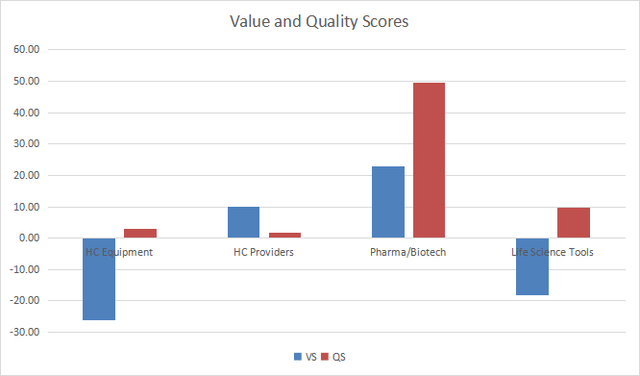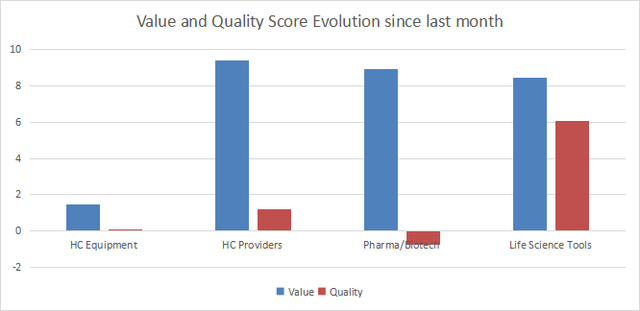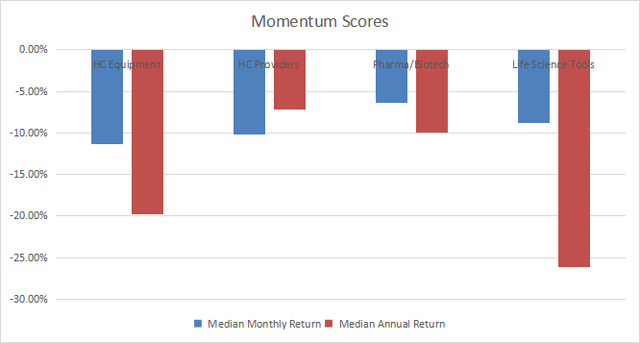[ad_1]
jeffbergen/E+ via Getty Images
This monthly article series shows a dashboard with aggregate industry metrics in healthcare. It may also serve as a top-down analysis of a number of healthcare ETFs like the Health Care Select Sector SPDR ETF (XLV) and the iShares U.S. Healthcare Providers ETF (NYSEARCA:IHF), whose largest holdings are used to calculate these metrics.
Shortcut
The next two paragraphs in italic describe the dashboard methodology. They are necessary for new readers to understand the metrics. If you are used to this series or if you are short of time, you can skip them and go to the charts.
Base Metrics
I calculate the median value of five fundamental ratios for each industry: Earnings Yield (“EY”), Sales Yield (“SY”), Free Cash Flow Yield (“FY”), Return on Equity (“ROE”), Gross Margin (“GM”). The reference universe includes large companies in the U.S. stock market. The five base metrics are calculated on trailing 12 months. For all of them, higher is better. EY, SY and FY are medians of the inverse of Price/Earnings, Price/Sales and Price/Free Cash Flow. They are better for statistical studies than price-to-something ratios, which are unusable or non available when the “something” is close to zero or negative (for example, companies with negative earnings). I also look at two momentum metrics for each group: the median monthly return (RetM) and the median annual return (RetY).
I prefer medians to averages because a median splits a set in a good half and a bad half. A capital-weighted average is skewed by extreme values and the largest companies. My metrics are designed for stock-picking rather than index investing.
Value and Quality Scores
I calculate historical baselines for all metrics. They are noted respectively EYh, SYh, FYh, ROEh, GMh, and they are calculated as the averages on a look-back period of 11 years. For example, the value of EYh for healthcare providers in the table below is the 11-year average of the median Earnings Yield in this industry.
The Value Score (“VS”) is defined as the average difference in % between the three valuation ratios (EY, SY, FY) and their baselines (EYh, SYh, FYh). The same way, the Quality Score (“QS”) is the average difference between the two quality ratios (ROE, GM) and their baselines (ROEh, GMh).
The scores are in percentage points. VS may be interpreted as the percentage of undervaluation or overvaluation relative to the baseline (positive is good, negative is bad). This interpretation must be taken with caution: the baseline is an arbitrary reference, not a supposed fair value. The formula assumes that the three valuation metrics are of equal importance.
Current data
The next table shows the metrics and scores as of last week’s closing. Columns stand for all the data named and defined above.
|
VS |
QS |
EY |
SY |
FY |
ROE |
GM |
EYh |
SYh |
FYh |
ROEh |
GMh |
RetM |
RetY |
|
|
HC Equipment |
-26.11 |
2.98 |
0.0274 |
0.2042 |
0.0230 |
13.86 |
67.86 |
0.0338 |
0.2830 |
0.0336 |
14.12 |
62.96 |
-11.36% |
-19.81% |
|
HC Providers |
9.95 |
1.62 |
0.0563 |
1.5122 |
0.0746 |
19.31 |
19.96 |
0.0527 |
1.4588 |
0.0625 |
15.90 |
24.40 |
-10.21% |
-7.19% |
|
Pharma/Biotech |
22.76 |
49.67 |
0.0487 |
0.2458 |
0.0494 |
41.02 |
79.97 |
0.0377 |
0.2552 |
0.0346 |
20.50 |
80.53 |
-6.38% |
-9.90% |
|
Life Science Tools |
-18.19 |
9.73 |
0.0300 |
0.1798 |
0.0267 |
17.62 |
59.22 |
0.0301 |
0.2948 |
0.0315 |
15.67 |
55.35 |
-8.83% |
-26.19% |
Value and Quality chart
The next chart plots the Value and Quality Scores by subsector (higher is better).
Value and quality in healthcare (Chart: author; data: Portfolio123)
Evolution since last month
Since last month, value scores have improved in all industries due to price action.
Variations in value and quality (Chart: author; data: Portfolio123)
Momentum
The next chart plots momentum data.
Momentum in healthcare (Chart: author; data: Portfolio123)
Interpretation
Pharmaceuticals/biotechnology is the most attractive subsector: it is undervalued by about 23% relative to 11-year average and the quality score is excellent. Healthcare providers are undervalued by about 10% regarding the same metrics and quality is close to the historical baseline. The next paragraph will focus on an ETF investing specifically in this industry. Life science tools and healthcare equipment are overvalued and their quality scores are slightly above the baseline.
Focus on IHF
The iShares U.S. Healthcare Providers ETF has been following the Dow Jones U.S. Select Health Care Providers Index since 05/01/2006. It has a total expense ratio of 0.42%, which is significantly higher than other passive index ETFs in healthcare like XLV (0.12%).
As of writing, the fund holds 72 stocks and is very concentrated in a few names. The next table shows the top 10 holdings with their weights, basic valuation ratios and dividend yields. Their aggregate weight is about 73%.
|
Ticker |
Name |
Weight (%) |
EPS growth %TTM |
P/E TTM |
P/E fwd |
Yield (%) |
|
UNH |
UnitedHealth Group Inc. |
22.32 |
3.86 |
24.74 |
20.84 |
1.46 |
|
CVS |
CVS Health Corp. |
14.52 |
7.22 |
14.73 |
10.62 |
2.48 |
|
ANTM |
Anthem Inc. |
8.02 |
35.91 |
17.49 |
15.52 |
1.15 |
|
HUM |
Humana Inc. |
4.63 |
-16.16 |
18.17 |
17.39 |
0.74 |
|
CI |
Cigna Corp. |
4.57 |
-30.56 |
15.17 |
10.75 |
1.83 |
|
CNC |
Centene Corp. |
4.50 |
-39.77 |
30.28 |
13.78 |
0 |
|
LH |
Laboratory Corporation of America Holdings |
4.33 |
-19.01 |
10.38 |
11.53 |
1.27 |
|
HCA |
HCA Healthcare Inc. |
4.10 |
58.88 |
8.14 |
10.00 |
1.29 |
|
DGX |
Quest Diagnostics Inc. |
3.17 |
14.07 |
8.71 |
14.16 |
2.02 |
|
MOH |
Molina Healthcare Inc. |
3.05 |
-3.52 |
21.37 |
14.58 |
0 |
IHF has outperformed the sector ETF XLV since inception, but the difference in annualized return is not really significant: 29 bps. It shows a much higher risk in drawdown and volatility. Therefore, its risk-adjusted performance (Sharpe ratio) is inferior to the sector benchmark.
|
Total return |
Annualized return |
Max Drawdown |
Sharpe ratio |
Volatility |
|
|
IHF |
437.31% |
11.00% |
-59.14% |
0.62 |
19.65% |
|
XLV |
415.29% |
10.71% |
-40.53% |
0.77 |
14.49% |
Data calculated with Portfolio123
In summary, IHF is designed for investors seeking capital-weighted exposure to healthcare providers. It may also be used as a component of tactical allocation strategies. The portfolio is concentrated in the top holdings, with almost 45% of asset value in the top 3 names. Exposure to risks related to UnitedHealth Group and CVS Health is especially high. Management fees and risk metrics are significantly higher than for broad healthcare index ETFs.
Dashboard List
I use the first table to calculate value and quality scores. It may also be used in a stock-picking process to check how companies stand among their peers. For example, the EY column tells us that a large pharma/biotech company with an Earnings Yield above 0.0487 (or price/earnings below 20.53) is in the better half of the industry regarding this metric. A Dashboard List is sent every month to Quantitative Risk & Value subscribers with the most profitable companies standing in the better half among their peers regarding the three valuation metrics at the same time. The list below was sent to subscribers several weeks ago based on data available at this time.
|
VIR |
Vir Biotechnology Inc. |
|
QDEL |
QuidelOrtho Corp. |
|
MRNA |
Moderna Inc. |
|
DVA |
DaVita Inc. |
|
ABC |
AmerisourceBergen Corporation |
|
OGN |
Organon & Co. |
|
THC |
Tenet Healthcare Corp. |
|
QURE |
uniQure N.V. |
|
HNGR |
Hanger Inc. |
|
ITOS |
iTeos Therapeutics Inc. |
It is a rotating list with a statistical bias toward excess returns on the long term, not the result of an analysis of each stock.
[ad_2]
Source links Google News

